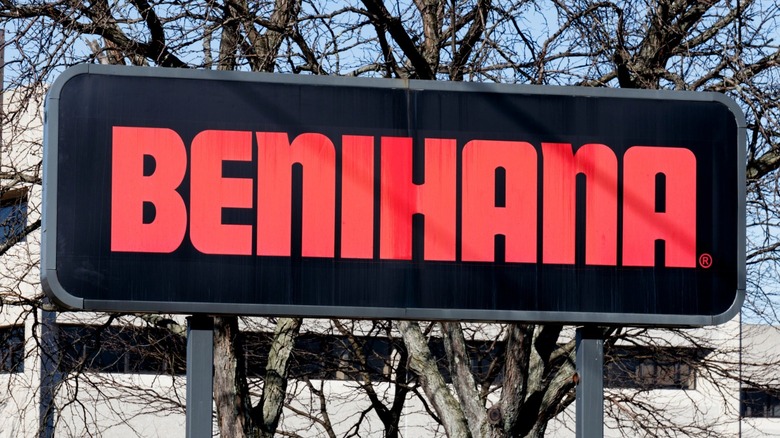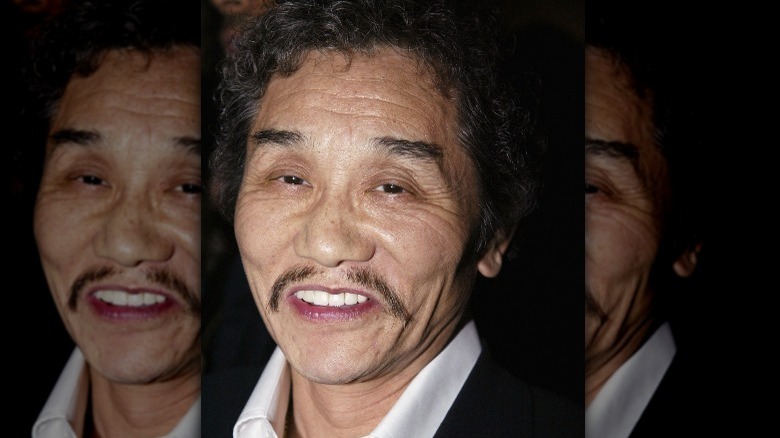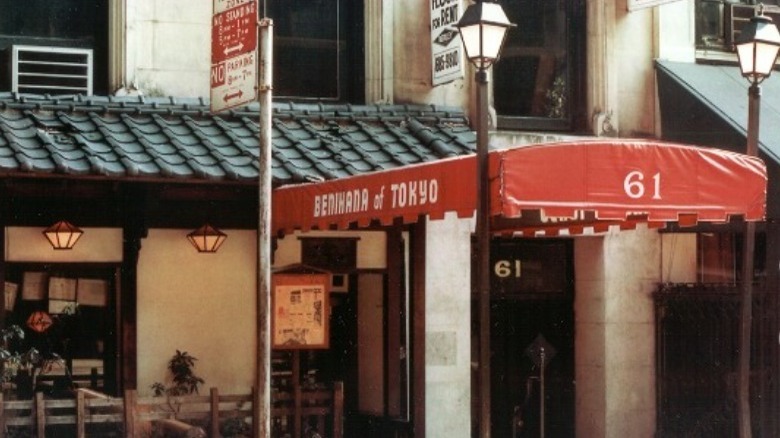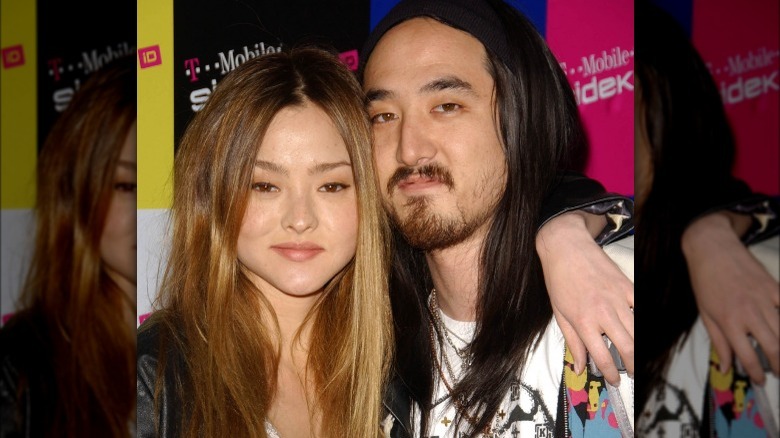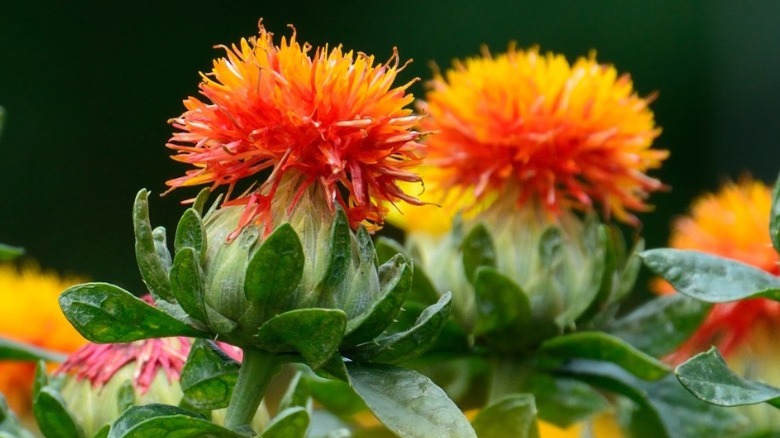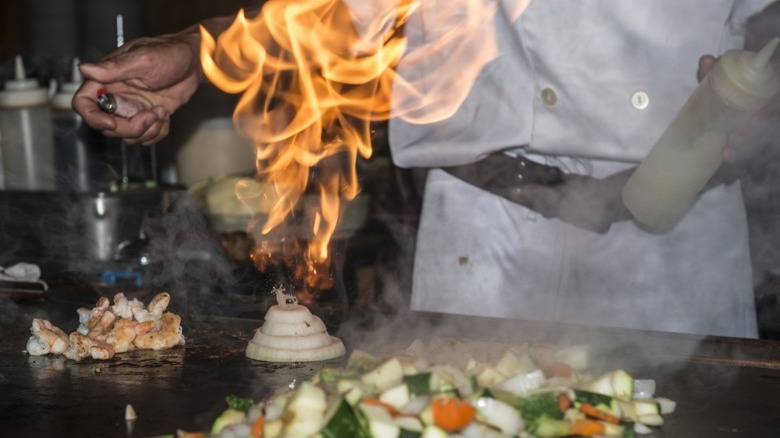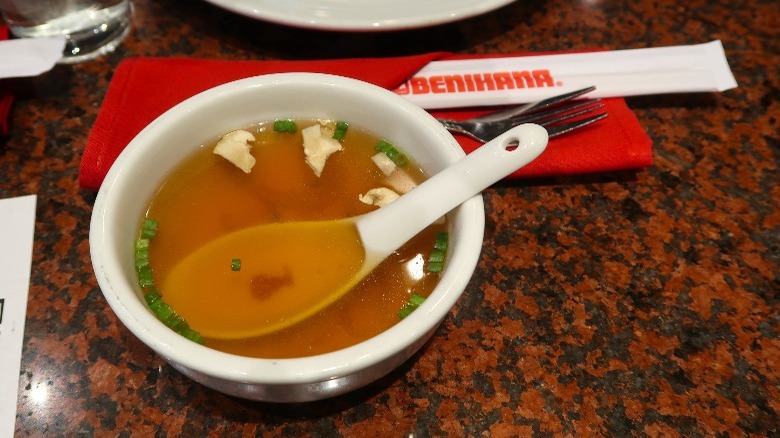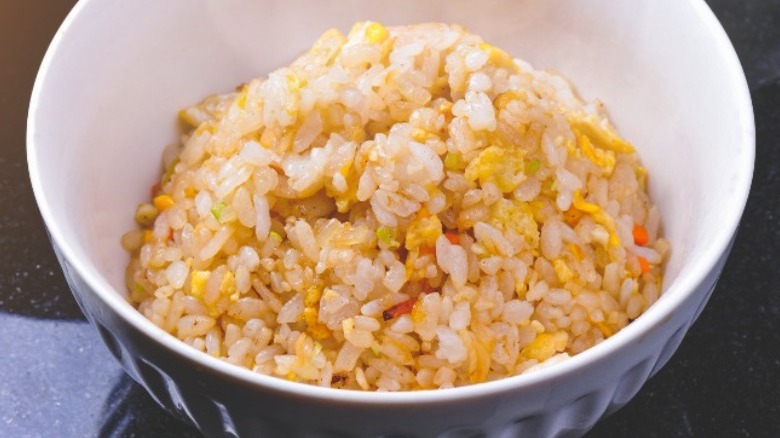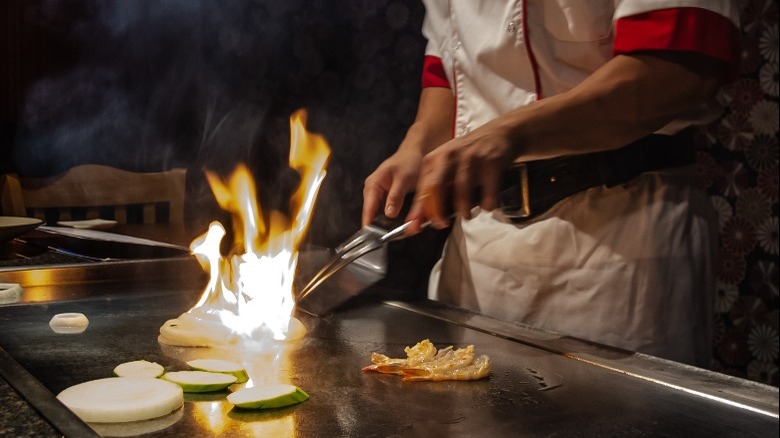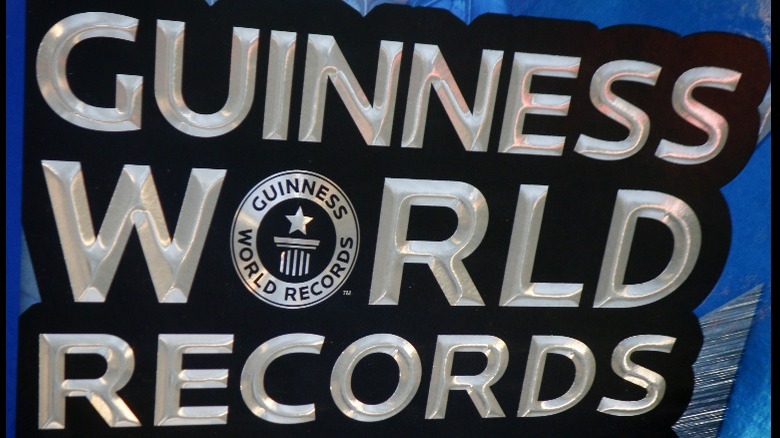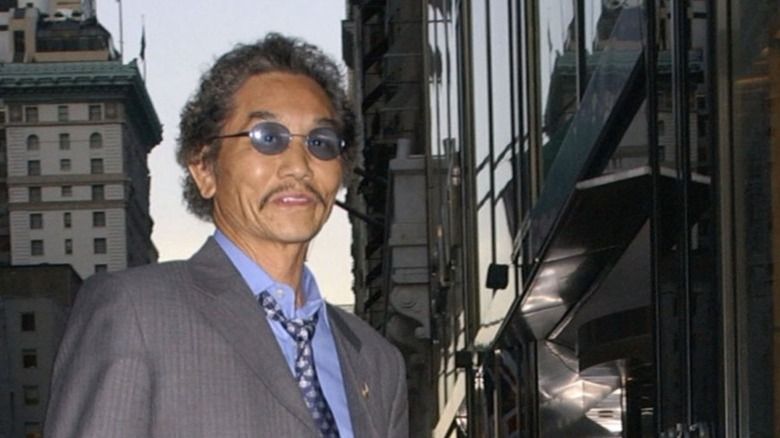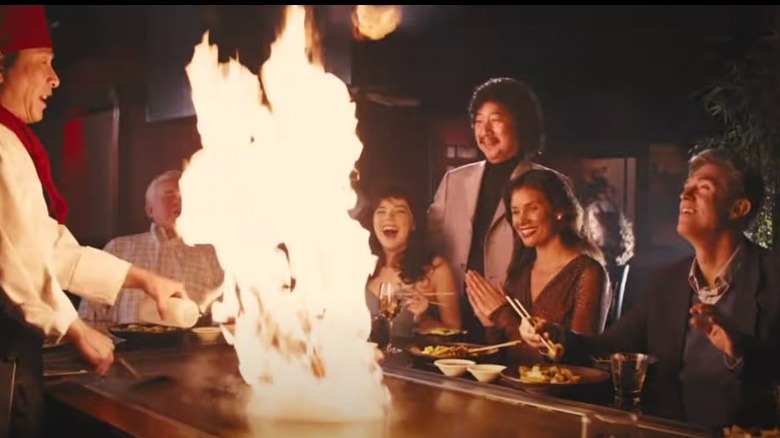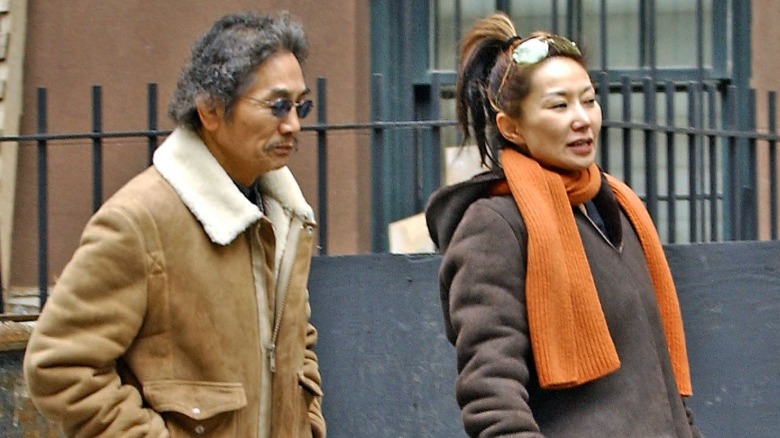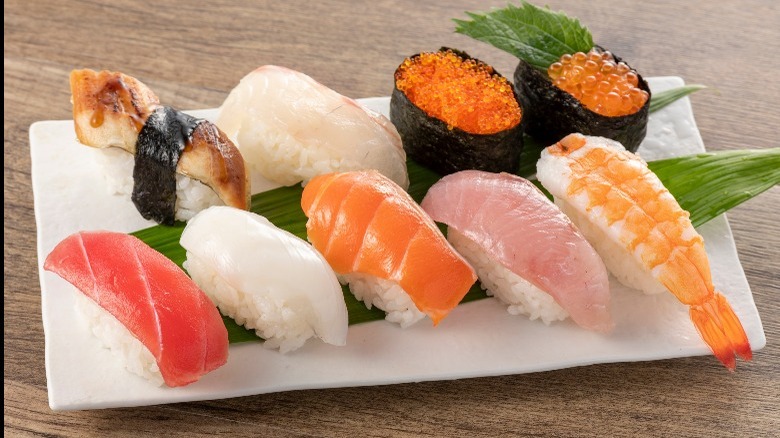The Untold Truth Of Benihana
This beloved American chain is known for providing both a Japanese-inspired meal and a fiery performance. Instead of simply eating a fresh, hot meal, you can watch it get cooked on a huge metal griddle before your eyes. The grilled shrimp, chicken, and steak can be very delicious, but the most memorable thing about going to Benihana is watching an acrobatic cook perform tricks like making a face from egg yolks, a heart from fried rice, and a volcano from onion rings (via Medium).
Behind each chef's talented performance lies the complicated history of the celebrated teppanyaki restaurant. Benihana's backstory involves a professional wrestler, a DJ, a model, a men's magazine, a Mr. Softee ice cream truck, and a handful of heated lawsuits fighting over the fortune of a company worth around $300 million in 2012 (via LA Times). There's a lot to learn about this unique chain that has been serving up delicious plates of Japanese-American cuisine for more than 50 years now. Here is the untold truth of Benihana.
An Olympic wrestler and ice cream man founded it
Benihana's story begins with Hiroaki "Rocky" Aoki. The Japanese wrestler's father, Yunosuke — a restaurant owner himself — was rumored to be the descendant of a samurai. Yunosuke seemed to pass that fighting down gene to his son, as Rocky was a skilled wrestler who qualified for the Japanese Olympic team in 1960. Although he didn't end up competing, this won Rocky a college scholarship which enabled him to move to the U.S. (via Thrillist).
Although the Benihana founder had a tumultuous university experience (including one expulsion due to fighting other students) he finished school in 1963 with a degree in management, according to Encyclopedia.com. Aoki's first endeavor as an entrepreneur was selling ice cream out of a Mister Softee truck in the Harlem neighborhood of New York City.
Aoki found success from the Mister Softee gig, eventually making around $10,000 in profits from working the summer of 1963 alone. The entrepreneur said there wasn't much competition, telling New York Magazine, "Everybody was afraid to sell ice cream in Harlem then." The wrestler-turned-driver even put his own spin on the ice cream truck, placing Japanese umbrellas in each cold treat. Once Aoki made $10,000, his father gave him an additional loan, and Aoki was ready to start his company.
New York City was home to the first restaurant
Using his new investment money, Aoki found a space in Midtown Manhattan on West 56th Street. There, he opened the first Benihana restaurant in 1964, at the young age of 26. The eatery's look was inspired by Japanese farmhouses, decorated with rustic-looking wooden beams and tatami mats (via First We Feast). The restaurant included authentic iron teppanyaki cooking grills inserted at the center of each table. This would become a Benihana staple, according to the company website.
The first Benihana location struggled to be super profitable at first, reports Eater. But luckily, it opened at an opportune time. Other blossoming dining chains such as TGI Friday's also launched their first restaurants in NYC during the 1960s (via TGIFridays). Benihana was in good company. Eventually, per Eater, the restaurant received a rave review from New York Herald Tribune food critic Clementine Paddleford that turned its fortunes around.
Dining at Benihana became a popular choice for celebrities and other wealthy New Yorkers. The Beatles and Muhammad Ali were both seen at Benihana around that time (via The Manual). Paul McCartney even visited the reopening of the Midtown location back in 2012 after it briefly closed for renovations. According to Grub Street, the famously vegetarian rockstar ordered tofu for that meal.
Siblings Steve and Devon Aoki are part of the family
Aoki's interesting family line doesn't end with him, it turns out. Both the famous electronic DJ Steve Aoki and the successful model Devon Aoki are his children. According to New York Magazine, Steve is the son of Aoki and his first wife, Chizuru Kobayashi. Devon, born in 1982, is the daughter of Aoki's second wife Pamela Hilburger, whom he dated while still married to Kobayashi (via The New York Times). Just like their father, Steve and Devon have experienced their share of fame and success.
Steve's career as a DJ and record producer has spanned decades. It includes numerous collaborations with different pop stars, including the likes of BTS, 2 Chainz, LMFAO, Iggy Azalea, and more, reports Billboard. In 2018, Forbes said that Steve was making around $28 million a year from his DJ career alone, making him one of the highest-paid performers of his kind.
Devon's fashion career began when she was discovered by none other than British supermodel Kate Moss, according to The Independent. From there, Devon became a star of late 90s and early 2000s fashion, walking in runway shows for brands including Diane von Furstenberg, Versace, and Oscar de la Renta (via Nylon). She has even acted in films such as "Sin City" and "2 Fast 2 Furious," per IMDB. Devon and Steve aren't Aoki's only kids: There are five other siblings, whom the Benihana founder had with three different women.
A Japanese flower inspired the name
On the less scandalous side of things, Aoki thought it would be sweet to give his chain a sentimental name. Benihana was the name of Aoki's parents' business back in Japan, which began as a coffee shop but was later turned into a full-service restaurant, according to Benihana International.
As Aoki told it, his father Yunosuke took a liking to the name when he came across a red safflower plant one day shortly after America firebombed Tokyo in 1945 (via New York Magazine). Yunosuke found the image of the plant growing out of the city's rubble inspiring and named his business after it. So did his son Rocky.
"Benihana" translates to "safflower." It's meant to refer to a certain Japanese type, which is typically red. According to Japan Times, the plant was previously used as a red color dye. Now, it's primarily grown to be made into safflower oil. Benihana took both the name of the plant and its image for their company logo. The flower even decorates some of Benihana's cookware (via Instagram).
Teppanyaki is the proper name for the famous cooking style
Since its launch in the 60s, all Benihana restaurants have utilized the teppanyaki style of cooking. Teppanyaki was invented by another restaurant chain, Misono, in 1945 (via Misono). It was Benihana, however, that popularized teppanyaki cooking in the U.S.
Whatever you do, don't get teppanyaki confused with hibachi. Although there are "hibachi" items on Benihana's menu, the two techniques are entirely different. While hibachi involves grilling over a gas or charcoal flame, teppanyaki is the style of cooking on a griddle-like, flat iron surface, reports The Spruce Eats. It's believed that teppanyaki evolved from hibachi, which may have been around since 794, if you can believe it.
The name teppanyaki comes from a combination of teppan (meaning iron plate) and yaki (meaning grilled or boiled food) according to Japan Today. Teppanyaki's style makes it easy to cook a quick meal by chopping food on the same surface it will be heated on. That's what enables the chefs at Benihana to cook dinner so swiftly while putting on a show.
To avoid stereotypes, they banned slimy foods
Along with the cooking style, Benihana's choice of ingredients was purposefully westernized. During the 1960s, stereotypes against Japanese people in America were still prevalent. The internment of Japanese people during World War II was less than 20 years in the past. As the result of persisting racism, Aoki decided to ban all foods that could appear "slimy or fishy" (as was the negative view of Japanese food then) to try to appeal to a more American palate, reports Business Insider. Instead, Benihana included American-friendly menu items like chicken, steak, and shrimp.
While inauthentic, Benihana's popularity may have paved the way other Japanese foods to become accepted in the states. The chain, along with other teppanyaki restaurants, certainly helped to increase the popularity of Yum Yum sauce (also known as white sauce), a mayonnaise-based condiment. The sauce, like Benihana itself, happens to be a Japanese-American invention, according to NPR.
To give them some credit, Benihana has slightly backed away from this tactic of avoiding certain Japanese ingredients in the present day. Now, the restaurant chain serves sushi, indicating they aren't afraid to serve "fishy" food anymore.
Garlic butter is the fried rice's secret ingredient
One of the more well-known Benihana menu items is fried rice. Not only is the rice served with most meals, but it's also a big part of most chef routines. While dining at Benihana, you're likely to witness the "beating heart fried rice" and the "rice bowl toss," the latter of which involves flipping then balancing an entire bowlful of rice on your metal spatula (via Business Insider).
What makes that rice so delicious is the inclusion of both garlic and butter (via PopSugar). This Insanely Good Recipes copycat Benihana fried rice uses an entire stick of butter is combined with garlic, lemon, and soy sauce to help flavor Benihana's rice dishes.
The rice is also cooked with safflower oil, says IzzyCooking.com. Safflower oil is used in cooking several menu items at Benihana — that's pretty on-brand, considering the name refers to the plant. The oil is well-suited for teppanyaki cooking because of its very high smoke point. Safflower oil has a smoke point of over 500 degrees Fahrenheit, which is higher than olive, canola, or sunflower oil, reports The Washington Post. That means the Benihana chefs are less likely to set off the smoke alarm or make their food taste burnt.
Benihana chefs are trained for weeks
Not surprisingly, some learning has to be done before Benihana chefs can put on the hat. To apply, chefs need to already have at least one year of cooking experience in a professional kitchen. After interviews, there's a required five-week training process. This training teaches chefs "advanced knife skills, scratch cooking mastery, and showmanship," according to the company website. Benihana doesn't say whether or not they teach stand-up, but comedy is sometimes a part of the dining experience as well.
Once trained, Benihana chefs aren't paid a massive amount for their hard work. But unlike some other chefs, the cooks at Benihana have the opportunity to collect tips. Indeed listed the average hourly chef wage as over $16 per hour. That's higher than the federal minimum wage of $7.25 per hour and higher than most states' minimum wage (via U.S. News & World Report).
If you're looking to learn some of the skills taught to Benihana chefs, there's also a way to do that without signing up for a job. The chain's Be the Chef program offers paid cooking classes for those wanting to learn how to make a flaming onion volcano. The program also provides food for a big group. It could be a better way to celebrate your birthday next year.
The company holds a Guinness World Record
The Benihana company is not one to shy away from a challenge. In 2018, they took that competitive spirit to the next level by attempting to set a Guinness World Record, according to PR Newswire.
Their chosen challenge, the longest cooking marathon, was attempted that year on National Fried Rice Day (September 20) — a holiday created by the company in a partnership with the National Day Calendar, reports Guinness World Records. Two chefs cooked for 42 hours and 17 minutes, successfully taking the record for Benihana. Over 1,000 servings of fried rice were cooked during that time, then donated to charitable organizations serving low-income residents of New York and Chicago.
This cooking marathon isn't the only time Benihana has broken a record. Rocky Aoki briefly held the world record for longest balloon flight, which he set in 1981 (via Washington Post). It was also the first manned balloon flight across the Pacific Ocean. For over 84 hours and more than 5,000 miles, Aoki and a few other crew members took a treacherous ride across the ocean in a vehicle decorated with the Benihana logo. Unfortunately, they crashed upon arriving in California. The disastrous landing knocked Aoki unconscious, but it didn't seem to bother him that much. He was quoted as saying, "If you are afraid to die, you are probably afraid to live."
The founder was busted for financial crimes
Aoki wasn't afraid of breaking world records. He wasn't too scared of breaking the law, either. In 1998, the Benihana founder was charged with insider trading. Prosecutors alleged that he profited from a tip to buy stock in a technology company called Spectrum. According to The Associated Press, Aoki was tipped off that an Apple chairman would soon be joining the company, allowing him to buy Spectrum's stock just before it rose by 46%, netting him a profit of about half a million dollars.
Once charged, he gave up his 51% interest in Benihana and resigned as a chairman, per the Los Angeles Times. In court, Aoki pleaded guilty to four criminal counts and was fined $500,000. He could have gone to jail for the crime but was able to avoid doing so because of his health issues. At the time he was charged, Aoki was 61 years old and was suffering from illnesses including hepatitis C. The founder claimed he contracted it from a blood transfusion during recovery from a boat accident (via The Hustle). Instead of being put away where he might have not been able to receive treatment, Aoki received probation and didn't have to go to jail.
'The Wolf of Wall Street' includes a scene at Benihana
If it wasn't clear already, the Benihana founder had quite the reputation. As the Benihana chain opened dozens of restaurants across the country, Rocky Aoki was elevated to a more glamorous lifestyle. The newly rich and famous restaurant owner didn't just have his share of girlfriends, he even founded a publication to celebrate his love of beautiful women: a men's magazine called Genesis (via The Hustle).
Aoki's reputation for the dramatic landed Benihana had a cameo in the 2013 movie "The Wolf of Wall Street." In it, Leonardo DiCaprio (as investor Jordan Belfort) crosses paths with Benihana founder Aoki and blames him for ratting out Belfort's financial crimes. Aoki is even arrested in a scene in the film (via YouTube). Steve Aoki was a fan of the film's reference to his father — despite it not being based in fact — saying of the movie, "They shouted out my dad and I thought that was really cool" (via Elite Daily).
That's not Benihana's only fictional cameo with high-rolling businessmen, either. A 2010 episode of "Mad Men" features Don Draper dining at the chain's first restaurant located in Manhattan. The season was set in the mid-1960s, a time period that corresponded with the real-life opening of Benihana's first restaurant, reports Eater. If Don Draper were real, he probably would've sampled the hit restaurant at the time.
Family legal battles ensued over the restaurant fortune
According to The Manual, the Benihana restaurant chain had around 100 locations at its peak. Rocky Aoki's net worth had grown to between $30 and $40 million by 2000, he told The New York Times. Sadly, in 2008, Aoki passed after contracting pneumonia (via NBC). The Benihana founder was 69 at the time.
Once Aoki passed, family disputes involving his inheritance exploded. Per the New York Post, although Aoki had three wives and seven children, the founder's will left much of the control over his funds to his third wife Keiko Ono when he passed. Aoki's children challenged the will, claiming that Ono was "squandering" the Benihana inheritance, which wouldn't pass to the Aoki children until their father's third wife died, reports The Daily Mail.
The most recent ruling decided that Aoki's children would split the Benihana funds, but not until each of them turns 45. In the meantime, Ono still controls the fortune as a trustee.
Benihana now operates sushi chains
As of 2021, there are over 70 Benihanas located worldwide, with the majority in the U.S. The company also owns restaurants in South and Central America, as well as the Caribbean, according to the chain.
Around 2000, the company expanded to take control of two additional Japanese restaurant chains. Benihana first bought Haru Sushi for around $8 million in 1999, reports BizJournals. In 2002, the group purchased RA Sushi.
The Benihana company's success continues. In 2012, the Benihana company was purchased by a private equity group for $296 million, according to CBS. Less than ten years later, its annual revenue was estimated to be $650 million by Dun & Bradstreet.
Some of Aoki's children have even taken on a larger role in the restaurant business. This year, brothers Steve and Kevin Aoki opened Kuru Kuru Pa, a restaurant located in Las Vegas, says Eater. Kuru Kuru Pa is a fast-casual restaurant serving grilled chicken skewers prepared in the yakitori style, their website says. Other Japanese foods like mochi and yaki onigiri (grilled rice balls typically stuffed with different fillings and partially wrapped in seaweed) are also on the menu. The logo appears to be an anime version of Steve Aoki, which is a fun touch. The grilled Japanese food restaurant continues Benihana's legacy of fun-spirited dining experiences.
